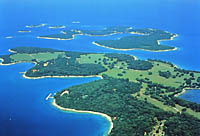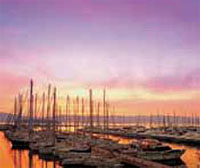Geographical position
Croatia extends from the foothills of the Julian Alps in the
north-west and the Pannonian Plain in the east, over the Dinara
mountain range in its central region, to the Adriatic coast in
the south.
Area
56,542 km2, with an
additional 31,067 km2 of territorial waters...

Kuna
(1 Kuna = 100 Lipa). There are 1, 2, 5, 10, 20, 50 Lipa
coins, 1, 2, 5 and 25 Kuna coins and 5, 10, 20, 50, 100,
200, 500 and 1,000 Kuna banknotes.
Foreign currencies can be exchanged at banks, exchange
offices, post offices and at most tourist agencies, hotels
and camping grounds. Banking hours are 7 a.m. to 7 p.m. from
Monday to Friday. On Saturdays banks are open until 1 p.m.
In the larger cities some banks are also open on Sundays.
Credit cards: Most hotels, restaurants and shops accept
credit cards (American Express, Diners Club,
Eurocard/Mastercard, Visa, Sport Card International). Cash
dispensing machines are ubiquitous...
 The
shallowest part of our sea is in Istria , where the depth does
not exceed 50 metres. From Pula , the seabed mildly drops,
making a long, narrow valley which extends from Zirje towards
Italy which is called Jabucka kotlina. The biggest depth there
is about 240 metres. From Jabucka kotlina, the bottom rises to
Palagruza reef where the biggest depth is 130 metres. Towards
the south, the bottom drops steeply towards the Juznojadranska
dolina, where the biggest measured depth is about 1,300 metres...
The
shallowest part of our sea is in Istria , where the depth does
not exceed 50 metres. From Pula , the seabed mildly drops,
making a long, narrow valley which extends from Zirje towards
Italy which is called Jabucka kotlina. The biggest depth there
is about 240 metres. From Jabucka kotlina, the bottom rises to
Palagruza reef where the biggest depth is 130 metres. Towards
the south, the bottom drops steeply towards the Juznojadranska
dolina, where the biggest measured depth is about 1,300 metres...
 Croatia is truly a land of islands because it has more than a thousand of them and each one is different. Many of them are inhabited but each and every one is exceptional, with its own story and destiny. To have a weak spot is human and the connoisseurs of Croatian islands have thousands of them. To be more precise 1185 of them. That’s how many islands, islets and cliffs are located in front of 1777 kilometers of the Adriatic coast. The first trip to the Adriatic coast and its islands is a journey into the unknown. Every other trip will be a journey to the already familiar beauty of this country, always different but equally breathtaking...
Croatia is truly a land of islands because it has more than a thousand of them and each one is different. Many of them are inhabited but each and every one is exceptional, with its own story and destiny. To have a weak spot is human and the connoisseurs of Croatian islands have thousands of them. To be more precise 1185 of them. That’s how many islands, islets and cliffs are located in front of 1777 kilometers of the Adriatic coast. The first trip to the Adriatic coast and its islands is a journey into the unknown. Every other trip will be a journey to the already familiar beauty of this country, always different but equally breathtaking...
 The Croatian coast, abounding in natural harbors, with its countless bays, beaches, ports and marinas is a real heaven for navigators. Natural indentedness of the Croatian coast enables rest and stopover in different surroundings.There are 50 marinas in Croatia , which is a member of the association of marinas and have 13.200 moorings in the sea and 4.500 on the land. Marinas continuously work to improve and enrich their services, and to adjust to the new needs and wishes of their guests.
The Croatian coast, abounding in natural harbors, with its countless bays, beaches, ports and marinas is a real heaven for navigators. Natural indentedness of the Croatian coast enables rest and stopover in different surroundings.There are 50 marinas in Croatia , which is a member of the association of marinas and have 13.200 moorings in the sea and 4.500 on the land. Marinas continuously work to improve and enrich their services, and to adjust to the new needs and wishes of their guests.
Many ports of nautical tourism made some additions to their service: traditional cuisine, water and electricity, doctor's services, services of charter companies, accommodation in apartments, and electronic surveillance and security of guests belongings.
The climate at the Adriatic is typically a Mediterranean one,
with mild rainy winters, and hot and dry summers. The air
temperature changes depending on the area. Thus, summer
temperatures in July will be about 34°C in the northern part,
while in the southern part they will rise even to 38°C. In the
winter, the coldest temperatures are noticed in the northern
Adriatic (up to -16°C), while they will not have exceeded 6°C in
the southern part...
 Croatian
cuisine is heterogeneous, and is therefore known as "the cuisine
of regions". Its modern roots date back to Proto-Slavic and
ancient periods and the differences in the selection of
foodstuffs and forms of cooking are most notable between those
on the mainland and those in coastal regions. Mainland cuisine
is more characterized by the earlier Proto-Slavic and the more
recent contacts with the more famous gastronomic orders of today
- Hungarian, Viennese and Turkish - while the coastal region
bears the influences of the Greek, Roman and Illyrian, as well
as of the later Mediterranean cuisine - Italian and French.
Croatian
cuisine is heterogeneous, and is therefore known as "the cuisine
of regions". Its modern roots date back to Proto-Slavic and
ancient periods and the differences in the selection of
foodstuffs and forms of cooking are most notable between those
on the mainland and those in coastal regions. Mainland cuisine
is more characterized by the earlier Proto-Slavic and the more
recent contacts with the more famous gastronomic orders of today
- Hungarian, Viennese and Turkish - while the coastal region
bears the influences of the Greek, Roman and Illyrian, as well
as of the later Mediterranean cuisine - Italian and French.